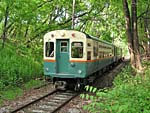
|
cta28d.jpg
(334k)
Car 28, freshly repainted in its 1959 colors, leads fellow
1-50 series cars 45 and 35
down Beulah Hill on the East
Troy Railroad on May 21, 2005. The car was repainted
from the 1980's Spirit of Chicago scheme, in which it
arrived at East
Troy, to its 1959 livery earlier in 2005 and the work
took approximately two weeks to complete. The interior has
not been repainted as of yet, but the museum plans to
eventually do so. (Photo by Eric
Zabelny)
|
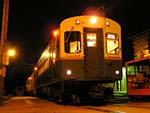
|
cta28e.jpg
(161k)
Car 28 sits out in front of the East
Troy Railroad depot in its original paint scheme on a
cool spring night on May 21, 2005. (Photo by
Eric Zabelny)
|
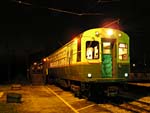
|
cta28f.jpg
(161k)
Resplendent in its 1959 as-delivered exterior livery, PCC
single car 28 is in front of the East
Troy Railroad depot on the evening of May 21, 2005.
(Photo by Eric Zabelny)
|

|
cta41d.jpg
(147k)
The view of car 41 at the Illinois
Railway Museum shows the motor cab interior of a typical
1-50 series car. The panel
in the left front side of the cab (center of photo) had all
of the commonly-used switches mounted on it, such as
controls for head- and taillights, marker lights, interior
and cab lights, windshield wipers, and more. Above the panel
is the Automatic Train Control (ATC) signal box, which shows
the motorman his speed, maximum allowable speed, and signal
indications. This is not an original feature and was added
later. In the left rear of the cab (extreme left of photo)
is another switch for the cab overhead light and an interior
speaker. In the lower right is the Cineston controller.
(Photo by Robert Feldman)
|

|
cta41e.jpg
(155k)
This view of of car 41's motorcab at the Illinois
Railway Museum shows a fuller view of the layout of a
PCC single-car's cab. In
the front center is the Cineston controller, which
controlled the motive power and electric brakes by moving
the handle from one side to another through power and brake
points. It's equipped with a deadman's feature, which puts
the car into "brake" if it's released, so don't forget to
hold it down! Above the Cineston in the window is the run
number box. The seat is swiveled so that the motorman could
operate the train, and then turn around to operate the
individual door controls in the rear of his cab or use the
farebox in the rear window of his cab if he were operating a
one-man run. (Photo by Robert
Feldman)
|
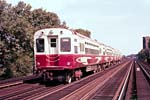
|
cta1e.jpg
(174k)
The first four 1-50 series
cars were experimental high-performance units, with
experimental controls, trucks, gear drives, axles, and
friction brakes. These cars, and the four high-performance
6000s also used in the
testing program, were painted in a distinctive maroon and
silver gray color scheme. The cars' colorful and playful
livery lead to them sometimes being referred to
affectionately as "the circus wagons". Car 1 is seen on
Track 2 of the North
Side Main Line in 1960. By 1964 the four cars were
repainted in the standard color scheme.
(Photo from the IRM Collection, courtesy of
Peter Vesic)
|
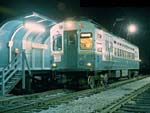
|
cta30d.jpg
(89k)
St. Louis-built car 30 is standing at the northbound
platform of Dempster
station after reaching the end of the Skokie Swift line on
an evening in April 1965. (Photo by Jerry
Appleman)
|
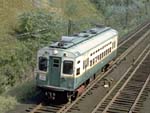
|
cta26e.jpg
(86k)
Car 26, built in 1959, is near Asbury Avenue on the Skokie
Swift in September 1966. (Photo by Jerry
Appleman)
|
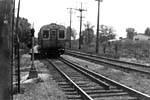
|
cta1-50s06.jpg
(103k)
A 1-50 series single unit
is operating on the Evanston shuttle nearing Isabella Street
in 1966. (Photo by Miles Beitler)
|








